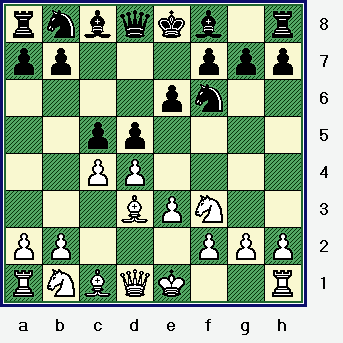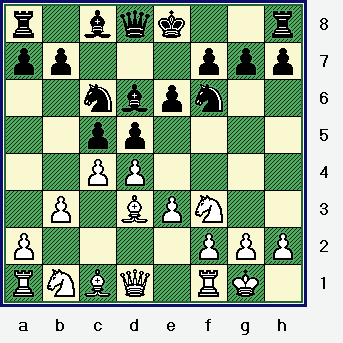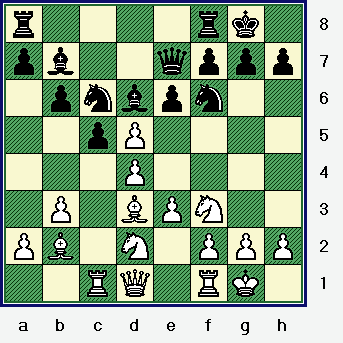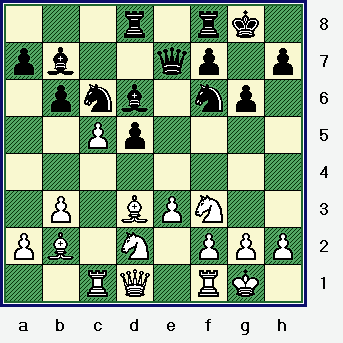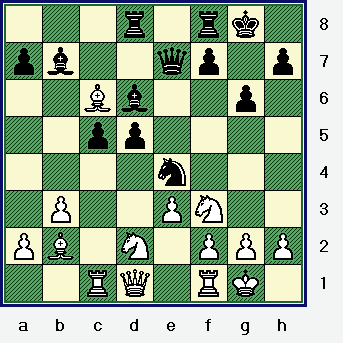All
the |
(Navigation bar
directly below.)
*******
© A.J. Goldsby, 2015.
(All rights reserved.)
****************
Click HERE
to see my
Chess Items.
****************
****************
Buy a book
from Amazon.com
(And help me out as well!)
****************
Click HERE
...
to see a list of the businesses that help to sponsor all of
my chess efforts.
Nimzovich - Tarrasch; St. Petersburg, 1914. |
This is mainly a text-based page ... but with plenty of diagrams. (15-20 game diagrams ... plus analysis.)
***
Click HERE to see a thorough explanation of the symbols that I use when annotating a chess game.
***
Click
HERE
to replay this game ... on a different web site.
(Warning! This is NOT one of my sites!!! If you find or see anything
offensive there, I am not responsible!)
(I only write this in response to some of the e-mails I have received. My advice
is ignore the language, or the bashing of any one individual ... if you cannot do this, then do not
click on the link!!)
Aaron Nimzowitsch (2620) -
Siegbert
Tarrasch (2662)
|
|
|
*********************
To me - a move that develops a
piece, controls the center (e4),
and prepares King-side castling;
... cannot be ALL wrong!
[ After the moves:
(>/=) 5.Nc3 Nc6; 6.a3!
a6!; "~" {Diagram?}
both sides reach a modern line
of this particular opening.
(The Semi-Tarrasch Defense.)
[ See any good, modern opening
work, like ECO, MCO,
or even
NCO for more information. ]
*** *** *** *** *** ***
*** *** *** *** *** ***
*** *** *** ***
I also have a web page that
contains a fairly thorough opening
survey
of this particular interesting
symmetrical opening system.
See the note after White's sixth move in that game. (Editor.) ]
5...Nc6;
(center?)
Nimzovich continues to develop here ... which is not a bad idea.
However, here (and on the next
move as well), the pawn capture
on d5 was probably
a little more
accurate than the text move.
[
>/= 5...dxc4!;
6.Bxc4 a6!;
"=" ]
6.0-0 Bd6!?;
7.b3!?,
{See
the diagram ... just below here.}
This is a rather tame move by
Nimzovich, who was already greatly
possessed of
a strongly original and
even bizarre mind-set as concerns
the opening.
*********************
|
|
*********************
Nimzo - true to form - interprets this
opening ... and the correct follow-up
for White ...
in a very unique way.
[
Probably a little better than the
actual game was:
>/= 7.cxd5,
"+/=" ('!') {Diag?}
with very good play for White.
]
7...0-0;
(King-safety.)
Perhaps since this game was
played in one of the greatest
tournaments ever held up until
that time ... both players are
{probably} a little nervous.
Against a lesser player, the great
German player and teacher may
have played to isolate his
opponent's
QP in this position.
I should also point out that Tarrasch
did NOT believe that the IQP was as
weak as some of
his contemporaries
have made it out to be. In fact, he
was one of the first to expound the
latent
strengths of a position with an
isolated center-pawn.
[ Possibly an improvement was:
7...cxd4!?;
"~" ('!') {Diag?}
with (MAYBE) the better game
for Black from this position. ]
8.Bb2 b6!?;
(fianchetto?) {D?}
More symmetry! (Will White play
Nc3 next, so as to restore the
perfect balance of this game?)
{Just a small joke.}
(Tartakower warns that Black
should not give White the hanging Pawns, as they could be
very dangerous for the second player here.)
[ Was >/= 8...cxd4!?; {Diagram?} more accurate? (I think so.) ]
****************************************************************
Now White should capture on d5,
but both players seem intent to
play very quietly here.
(Many
pundits have pointed out that
Nc3 was also better than the
text move that is now
selected
by White here.)
9.Nbd2!? Bb7;
10.Rc1!?,
This move looks natural - if at the
same time - a little unambitious.
Deep Junior likes the exchange on
the d5-square, as do several other
programs.
One pundit thought that
White should play a3 followed by
Qe2, which seems to
be a
reasonable suggestion at this point.
[ Maybe better was: 10.a3, "~" {D?} to possible prevent ...Nb4. ]
Now the latest version of Hiarcs
recommends that Black swaps
Pawns on d4 ...
or else plays
the (sensible) move of ...Rc8.
10...Qe7!?;
11.cxd5!, {See
the diagram - just below.}
One of my first choices in this
position ... and also the FIRST move
selected by several
chess programs!
(The authors of the Mammoth Book
give this a dubious ... but that seems
more than a little
hyper-critical ...
and even downright wrong to me.)
Reinfeld - among other annotators -
gave this move a whole question
mark in this position. ('?')
So it
would seem that many annotators
are simply following suit ... and
doing NO creative or
individual
thinking of their own!
*********************
|
|
*********************
The original tournament book
called this a ... "petite error."
(It was criticized for freeing Black's
game. However - as many of the
analogous positions
of the TMB
System prove - when Black
fianchetto's his QB in a double-QP
opening, it
is often useful for White
to exchange on d5 to make it more
difficult for Black to get his
light-squared Bishop into the game.)
[ Or maybe Nimzovich could have
tried the following line:
11.dxc5 Bxc5; 12.Qe2,
"+/=" {Diagram?}
and White is slightly better.
***********************************************
***********************************************
GM John Nunn - very erroneously -
claims that Ne5 represented
a
large improvement here.
For example: (</=)
11.Ne5?! cxd4!; 12.Nxc6,
{Diagram?}
Several programs give this as
being virtually forced for White ...
who am I to argue?
*** *** *** *** *** *** *** *** *** *** *** *** *** *** ***
( The Mammoth Book instead
gives the following continuation:
12.exd4?! Nb4!;
{Diagram?}
A substantial improvement over
Nunn's feeble line.
( Nunn's original line is/was: </=
12...Ba3?!; 13.cxd5 Nxe5?;
14.Bxa3 Qxa3!?; 15.dxe5, "+/=" {Diagram?}
and now Nunn says that Rc4!
gives White a strong attack. )
13.Bb1 dxc4;
("=/+") {Diagram?}
A very long analysis that I did
several years ago ... showed
that Black is at
least equal here,
maybe even a little better. {A.J.G.} )
*** *** *** *** *** *** *** *** *** *** *** *** *** *** *** *** *** ***
(Returning to the main path of
our analysis here.)
12...Bxc6; 13.Bxd4 Ba3;
14.Rc2 e5; 15.Ba1!?, "="
{Diagram?}
I would say ... that after some very
EXTENSIVE computer testing ...
that Black is OK here! {A.J.G.}
]
11...exd5!?;
(hmmm)
Almost predictably - Tarrasch
plays to keep pawns in the center.
[ Was 11...Nxd5!?; playable? (And maybe a little better?) ]
12.Nh4!?,
(Maybe - '!')
White forces Black to weaken
himself with ...g6.
Almost amusingly, this is the same
kind of maneuver that Tarrasch
himself used to win many
chess
games. So in a way - Nimzovich
is forcing his opponent to play
against himself.
Nunn - who obviously got up on the
wrong side of the bed the day that he
tried to annotate
this game - awards
this move the "?!" mark, and calls
the play of Knight/f3-h4, ... ... ...
"An extravagant maneuver." (Not!)
[ After years of thought, I now
believe that the best line is:
>/= 12.dxc5! bxc5;
13.Re1,
"+/=" {Diagram?}
and White is a shade better. ]
12...g6;
('!?')
{Box?}
This looks positionally forced ...
Black should not allow White to
get the Knight to f5.
[ One author claimed that Black lost if he allowed Nf5.
But this
is complete nonsense. Viz:
"=" 12...Nb4!?;
13.Bb1 Ba6!?;
14.Nf5 Qe6; 15.Nxd6! Bxf1;
16.dxc5 Ba6; 17.Bf5 Qe7;
18.Bd4 Rad8;
19.Bb1 Nd3; 20.Bxd3 Bxd3; 21.b4,
"~" {Diag?}
While White has very good play
here, the first player's position is
hardly
one I would call over-whelming ... in any way.
]
13.Nhf3 Rad8!?;
">>>"
Centralization - which, in my
book, is almost never bad.
None-the-less, one writer wrote that Black missed a big chance to play ...Nb4 here.
[ After the moves of:
(</=)
13...Nb4!?; 14.Bb1 Ba6!?;
15.Re1,
"~" (Maybe "+/=") {Diagram?}
White seems to be OK ...
several programs even seem to 'think'
that White is possibly a
little better in this position.
Fritz 8.0 - after nearly ten
minutes of 'thought' - awards
White
an evaluation of "+ 0.28,"
meaning that maybe the move
of
13...Nb4; was not so hot for
Black after all. ]
14.dxc5!;
(line opening)
{See the diagram - just below.}
With the long diagonal slightly
weakened, this move is definitely
called for in this position.
{It is also the first choice of several
strong computer programs here.}
*** *** *** *** *** *** *** *** *** *** *** *** *** *** *** *** *** *** *** ***
(COUNTERPOINT:
"White's position
is uncomfortable, and a satisfactory
continuation
is hard to find."
- Edward Lasker, in his book.)
*********************
|
|
*********************
However!!!!! This same move is also
the reason that Black has hanging
Pawns ...
and is also responsible for
releasing Black's center Pawns ...
for the later winning advance.
(Two
sides of the same coin!)
[ Also possible was: 14.a3!? ]
14...bxc5;
15.Bb5!?, ('Maybe - ?!')
A rather pointless looking move
... that GM J. Nunn strangely calls ...
"Relatively best."
(I cannot help
myself ... I won't resist the impulse
to quote Arsenio Hall here:
"Things that make you go ... HMMMMMMMMMMMMM!!!")
"Again - very subtly played." - The Book of the Tourney
*********************
[ Better was:
>/= 15.Re1!,
"+/=" {Diagram?}
and White looks to be on top,
albeit by a small margin. ]
15...Ne4!;
(Pow!)
Tarrasch is not impressed by
his opponent's 'threats,' and now
{correctly} slams
the Knight down ... occupying the outpost square.
'!' - Fred Reinfeld
[ {also} Playable was: 15...a6!?; "~" with a roughly equal position. ]
16.Bxc6!?,
(dubious?)
Nimzo - voluntarily - gives up a
Bishop in a semi-open position.
Positionally this is a somewhat
questionable concept. But I never
felt that this move was so terrible ...
and the computers see little or
no change in their scoring of this
particular position after this move.
The authors of the 'Mammoth Book' ... {see
the bibliography at the end of this game}
(Nunn?) gives this a whole question
mark here. (Also, '?' - Fred Reinfeld.)
I feel - VERY strongly - that this is
completely uncalled for, and also
totally
and completely incorrect!
*********************
|
|
*********************
Probably Qe2 or Re1 was a little better here (than what was played in the actual game).
[ Or slightly better than the game
would be the continuation of:
>/= 16.a3!?, ('!')
16...a6;
17.Bd3 f5;
"~" {Diagram?}
with a very dynamic position.
]
16...Bxc6;
17.Qc2, (Is this move an error?
Some commentators even praised it!)
This looks logical ... and is even
the first choice of several computers.
But perhaps h3 was a little wiser,
and might have prevented what
{now} happens in the game.
Nunn recommends the exchange
on the e4-square ... which also might
have prevented what
occurred in
the game.
"White's position really looks good
and shows no {sign of} weaknesses."
- Georgi Marco
(Writing for a German magazine
of that period.)
*** *** *** *** *** *** *** *** *** *** *** *** *** *** *** *** *** *** ***
As natural as White's last move
looked ... it is quite possible that
this was ... "The losing move,"
here for White!! (The combination
of three moves by White: Bb5!?
Bxc6, and Qc2 {?} were
probably
the factors that allowed his erstwhile opponent to win this game.)
[ After the following moves:
(>/=) 17.h3!? f5!;
"=/+" {Diagram?}
Black is slightly better ...
but there is no immediate forced
win in sight for White.
**********************************************
After the following continuation:
</= 17.Nxe4?! dxe4; 18.Nd2 Bb5!;
19.Re1 Bc7!;
17...Nxd2!?;
(why?) (Maybe - '!' or '!!')
{See the diagram ... just below.}
*********************
*********************
'!' -
Fred Reinfeld. '!!' - The Book of the Tournament
However - - - if Black already saw
that he had a forced win here ...
[ The
'box' likes:
(>/=) 17...a5!;
"~" {Diagram?}
****************************************
Also good for Black is:
18.Nxd2,
{Box?}
{See the diagram - just below.}
*********************
*********************
The position looks - at least
superficially - to be dry and even
somewhat drawish.
[ Grossly inferior would be:
18...d4!!;
(huh?)
{See the diagram ... just below.}
*********************
*********************
However, after a fairly monotonous
and boring opening, Tarrasch comes
alive and begins to
*** *** *** *** *** *** *** *** *** *** *** *** *** *** *** ***
*** *** *** *** ***
"This preliminary pawn offer allows
the c6-Bishop to join in the fun" - [The Mammoth Book Of]
[ Possible
was: 18...Rfe8;
"~" ("=/+") ]
19.exd4!?;
(Possibly - '?')
I am not sure what to think of
this move ... although White
could have been asleep here.
One author labeled this as ...
"The LOSING move." Of course,
he is probably the same
*******
NOTE: Fritz 10's evaluations switch from a relatively small advantage for
Black ...
[ After the moves:
"=" 19.Nc4!? Bb8;
***
( MUCH better would have been: >/=
19...Bxh2+!!; 20.Kxh2 Qh4+;
***
20.exd4 cxd4;
"=" The position is equal, or even
slightly better for Black.
**************************************************************
White could try (instead):
(>/=)
RR19.e4!? Qh4?; {D?}
20.g3 Qh3;
"~"
"/\"
*************************************************************
Maybe
White should have tried: 19...Bxh2+!;
{See the diagram just
below here.}
'!' - GM John Nunn.
'!' - FM Graham Burgess. '!' - Reuben Fine.
*********************
*********************
All very, very, very impressive ... and
this combination has been praised for
a very long time ...
[ "The first part of the classic
double Bishop sacrifice. It was made
famous by the game
But if you give this position to a
really strong program like Fritz 8.0,
and let it "cogitate" for
[ A
large
improvement would be:
>/=
19...Bxg2!!; ('!!!') 20.Kxg2[],
{Diag?}
( After the moves:
20.f4 Bxf1; 21.Nxf1 Bxf4; "-/+" White's game looks bleak. )
20...Qg5+!; 21.Kh1[],
{Diagram?}
( </= 21.Kf3?? Rfe8!; "-/+" )
21...Qf4!; 22.Nf3[],
{Diagram?}
*******
(
a.)
Of course NOT
the insane:
</= 22.f3
???, 22...Qxh2#.
b.)
White also loses after:
</= 22.Kg2?! Qxh2+;
{Diagram?}
23.Kf3 Rfe8!;
{Diagram?}
24.Rh1,
{Diagram?}
Relatively best ... in the given situation.
(The box gives: 24.Qe4!?[], {Diag?} {sacrificing
the Queen!}
24...Qf4+; 25.Kg2 Re2;
{Diagram?} *******
22...Qxf3+; 23.Kg1 cxd4!;
24.Qc6, (hmmm)
{Diagram?}
( After the moves: </=
24.Bxd4?! Bxh2+!; {Diagram?}
25.Kxh2 Rxd4; ("-/+") {Diagram?}
& Black has an easy win. )
24...Bxh2+!; 25.Kxh2 Rd5!;
"-/+" {See
the diagram - - - just below here.}
*****************************
{Analysis
Diagram}
*****************************
Now - in order to prevent the
coming mate - White must give
up the Queen here. ]
20.Kxh2 Qh4+;
21.Kg1 Bxg2!!;
{See the diagram just below.}
And although this double-Bishop sacrifice has been done
before ... this game
*********************
*********************
A good place for a "look-see." (A diagram.)
"A complementary sacrifice: The King's field is entirely
bare." - GM Savielly Tartakower.
[
</=
21...Rfe8!?; ('?')
22.d5!,
"+/-" ]
22.f3[],
{Box?}
{See the diagram - - - just below here.}
*********************
*********************
"This feeble-looking move is
all that is left for White." - Fred Reinfeld
[ After the following moves:
( But not: </= 24.Rg1?? Rh5#. )
24...Rh5+; 25.Qxh5 Qxh5+;
26.Kg3 Qg5+; 27.Kf3 Qxd2;
"/+"
22...Rfe8!; (Maybe,
probably - '!!')
Both Nunn and Reinfeld give this
move an exclam ('!') here.
"A beautiful waiting move," says Tartakower and J. du Mont.
*******
[ After the continuation:
</= 22...Bh3!?;
('?!') 23.Ne4!,
"~" {See the diagram -
below.}
*****************************
{Analysis
Diagram}
*****************************
Black might even have difficulty trying to find the win.
]
*********************
23.Ne4!?,
(hmmm)
[ The alternative is:
( Or 26.Kg3 Rd5; "-/+" )
26...Rd5; 27.f4 Rh5;
("-/+") {Diagram?}
*********************************************
</=
23.Qd3? Qg3!; - Fred
Reinfeld.
Black could lose his way with the
capture on f3, but Tarrasch has no
intention of letting
His only choice is resignation
- against a very bitter rival.
"Despair," says Reinfeld here.
*********************
*********************
The one positive aspect to this move
is that it opens the long diagonal for
White's latent Bishop.
[
</=
25.Rxf1?? Qh2+; 26.Ke3 Qxc2;
"-/+" ]
25...f5!;
(Nice!)
{See the diagram - - - just below.}
*********************
*********************
Black takes advantage of the fact
that the Black Bishop is immune, as
capturing would drop
Nunn claims that: "Black could have
won more easily by 25...Qg2+!; 26.Ke3, {best}
My only advice to Nunn is to check
his brand of tobacco!
[ Or
25...Qg2+; 26.Ke3 f5; "-/+" ]
26.Qc3, ('!?')
The computer finds a way to prevent
mate ... but only at the cost of
massive losses in material.
[ According to the box- it was
better to play the following
continuation:
( After: </= 27.Nxe8? Rxe8;
"-/+" {Diagram?}
27...Rxd5!, ("-/+")
{Diagram?}
26...Qg2+;
27.Ke3[],
[ But not:
</=
27.Ke1?? Qe2#.
]
27...Rxe4+!!;
{See the diagram given
... just below.}
*********************
*********************
"One murderous blow after
another." - Fred Reinfeld <<
Mass production in sacrifices! >>
- GM Savielly Tartakower and James du Mont
*******
28.fxe4 f4+!?;
(hmmm) {D?} Nunn goes on to state that:
[ The most efficient method of
execution for Black was:
***************************************************
Black could have also mated in
the same number of moves
29.Kxf4 Rf8+;
('!') 30.Ke5[],
(Ugh!) {See
the diagram given - just below.}
*********************
*********************
White's King ... way out in the
middle of nowhere, on the fifth
rank no less ...
[ Or
</=
30.Ke3?! Qf2#.
]
The
rest needs no comment ...
(other than to point out that A.N.
could have lasted 30...Qh2+!;
31.Ke6!? Re8+; 32.Kd7,
[ Or White could (instead) play:
32.Kf6 Qh4#.
{Diag?}
32...Bb5#.
('!')
{See
the diagram - just below.}
*********************
*********************
A
grand game by Tarrasch. While the
opening is more than a little droll, and
the conception << A justly famous game, in which
the tension in the centre is suddenly relieved by a diversion **************************************************************************
I consulted MANY books while trying
to annotate this game. I purposely
did NOT use any books that contained
material written by either Tarrasch or
Nimzowitsch - - figuring neither
player was capable of being totally
frank or completely unbiased ...
as concerns this game.
I did consult the following books ...
given roughly in the order that I
pulled them out of my library:
************
# 1.) [The Mammoth Book Of]
"The World's
Greatest Chess Games,"
This is a fantastic book ... each game
is analyzed in great depth. Additionally
all the players are given with a brief
introduction, biography, and a brief
synopsis of their respective careers.
---> At the end of the game, you
are given useful insights and
lessons to be learned from each
of these royal battles.
** ** ** ** ** ** ** ** ** ** ** **
** ** ** ** ** ** ** ** ** ** ** ** ** ** ** ** **
# 2.) "Tarrasch's Best Games
of Chess," by Fred Reinfeld. (Dover)
# 3.) The Official Book of the
Tournament / St. Petersburg, 1914.
# 4.) "Chess Highlights of
The
20th Century,"
# 5.) "Aaron Nimzowitsch:
(1886 - 1935) A reappraisal," by GM Raymond
Keene.
# 6.) "Chess Strategy,"
by {IM} Edward Lasker.
(Originally printed in - 1915)
# 7.) "The World's Great
Chess Games," by GM Reuben Fine. #
8.) The one and only fantastic book - "500
Master Games of Chess,"
by GM Savielly Tartakower and James du Mont.
Copyright (c) 1952.
*******************************************
Copyright (c) LM A.J. Goldsby I / Copyright (c) A.J.G; 1983 -
2013.
Copyright (c) A.J. Goldsby, 2005. All rights reserved.
20.Bc3 f5;
"/+" {Diagram?} Black is clearly better. ]
This is a rather tame move ...
and a little out of character for
the great Tarrasch.
(I would
have played ...f7-f5; here ...
with seemingly a great position
for Black.)
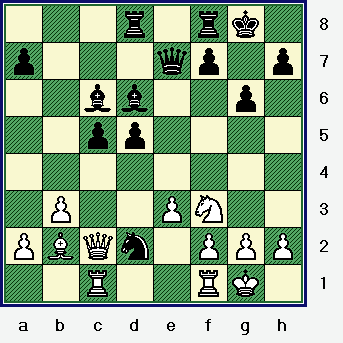
it could be argued that this move
deserves about three, four, (or
perhaps even five);
exclamation
points for Tarrasch!
with a good position for Black.
17...Bb7!?; 18.Rfd1 f5;
"=/+" {Diagram?}
with a good game for Black. ]
This is very close to being forced
for Nimzovich in this position.
("The guardian of the King's field leaves his post, but for a moment - assuming wrongly
that 19.Qb3 was the major threat." - GM Savielly Tartakower)
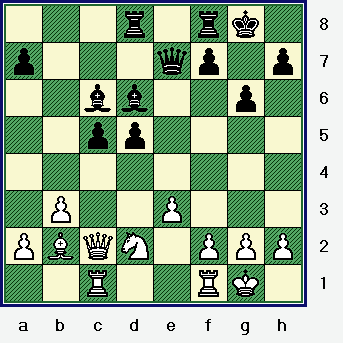
(If White is
given just one or two tempi, the
White dark-squared Bishop on
the long
diagonal could mean
something for Nimzovich.)
</= 18.Qxd2!? d4; 19.exd4?! Bxf3;
20.gxf3? Qh4; "-/+"
{Diag?}
and Black is winning. ( - GM J. Nunn ... in the
'Mammoth Book.' ) ]
Initially this move just looks like
a blunder ... since after an exchange
of Pawns on d4,
the Black Bishop
on c6 would be hanging.
('!' - FM Graham Burgess.) ('!' - {IM} Edward Lasker.)
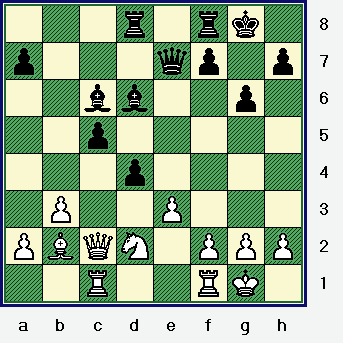
sense a few of the
latent possibilities here. (According
to one Russian Archivist, Black
thought
for nearly one hour here,
before playing this shot.)
"The World's Greatest Chess Games," by GM John Nunn,
GM John Emms & FM Burgess.
(Game # 14; beginning on
page # 79.)
(Good, bad, or in between?)
(If so, I am sure that the moves
that Tarrasch played next ...
quickly woke him up!!)
kind of guy
who goes out and buys a padlock for
the horse stall ...
AFTER the animal has been stolen!
to Black is winning by over three points. So I guess the debate
over what the losing move
would be is finally over!
- A.J. Goldsby I (Monday; May 07th, 2007)
The move given by one popular
chess program ...
of course it is NOT
nearly as convincing as the
line given by John Nunn here!
21.Kg1 Bxg2!!; 22.Kxg2 Qg4+!; 23.Kh1 Qf3+!; 24.Kg1 Rd5!;
25.Rfd1? Rh5; "-/+"
{Diagram?}
and White cannot avoid mate. Analysis by - GM John Nunn
)
(Taking on d4 is met by ...Bxh2+;
followed by ...Qh4+.)
**************************************************************
This straight-forward move is
just too easily met here.
(...f5; "=/+"
or ...Rfe8; was better.)
Black has a slight initiative.
Analysis by - Fred Reinfeld.
>/= 19.Rfe1!
Rfe8!; "=/+"
20.g3!?[],
(but) Black is still better here. ]
Tarrasch finds a very powerful
way to open up White's King.
'!!' - Fred Reinfeld.
'!!' - Edward Lasker.
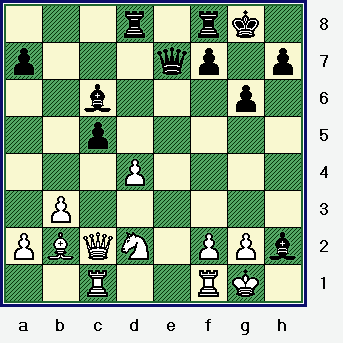
by a whole host of
chess masters and chess authors.
Em. Lasker -
Bauer; Amsterdam, 1889 ... and has
demolished many a King-side in the
years since. Nimzowitsch was, of
course, aware of the idea; but there
was little he could
do to prevent it."
- GM J. Nunn, in the Mammoth Book of games.
{See entry No. # one in the bibliography at
the end of this game.} ]
just a few minutes - the box comes up with
something even better for Black!
Very close to being forced.
There isn't much choice for White
in this position.
How do you stop the impending
mate in this position?
Taking first looks best.
This nice 'waiting move' ... cuts off the potential flight of the
hapless White Monarch.
but few humans would be happy playing this move.)
and Black is winning ("-/+") easily in this position.
(The only move to avoid mate that the computer can find is for
White to play Ne4 in this position.
---> I think that I would prefer resignation!) )
Note
added: 09/22/04.
Why not? Everything else loses
here for White!
Getting tired of this trick yet?
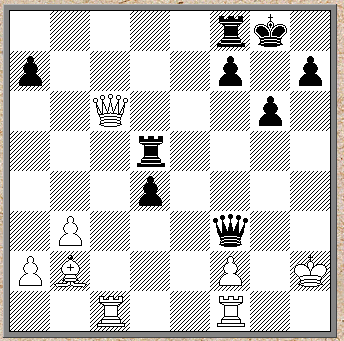
Without this move ... the attack
would probably come to a grinding
halt.
could easily
be its most attractive vehicle.
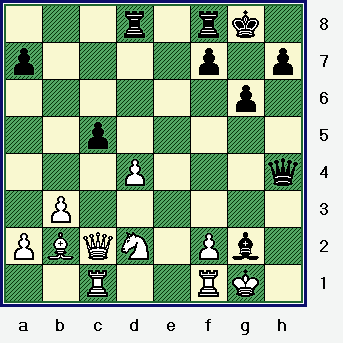
Nunn calls this the only chance.
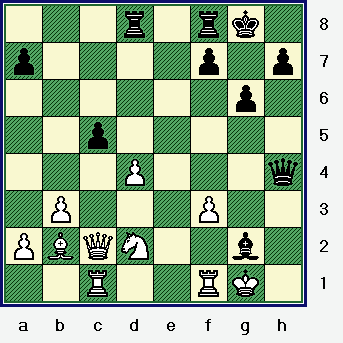
22.Kxg2!? Qg4+; 23.Kh2 Rd5;
24.Qxc5[], {Diag?}
Nunn - AND ... the computer -
say that this is forced.
Black is, in all probability, winning
the game here. ("-/+") ]
"The last Black piece joins the
attack. Tarrasch threatens the
instantly decisive 23...Re2."
- GM John Nunn (Who got at least one thing right
as concerns this game!)
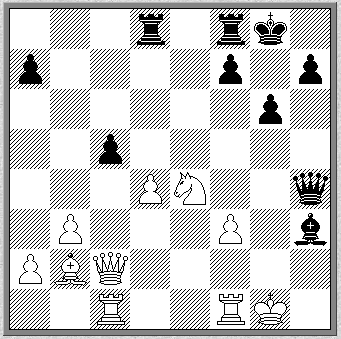
Probably the trickiest try here.
23.Rfe1 Rxe1+; 24.Rxe1 Qxe1+;
25.Kxg2 Qe2+;
26.Kg1!?,
{Diagram?}
The sanest-looking move here.
There is no stopping Black's
attack now.
24.Ne4!? Rxe4!; 25.Rf2 Bxf3+;
26.Kf1 Qh3+;
27.Kg1 Qh1#.
]
Nimzovich slip
through his fingers.
23...Qh1+!;
24.Kf2 Bxf1; 25.d5!?,
{See
the diagram - just below.}
"Nimzovich struggles on ... " - GM John Nunn
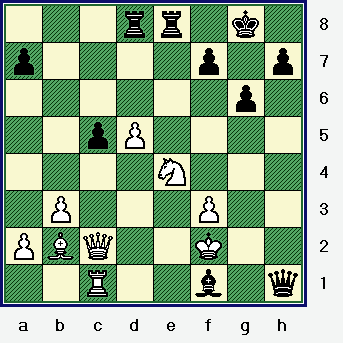
-----> (Too little, too late!!)
The first choice of Fritz 8.0 ... by about 5-10 points!!!
('!' - Fred Reinfeld.)
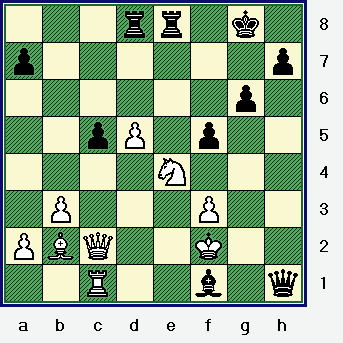
the White Q
to a check/x-ray attack.
(26.Ke1, Qxf3 '-/+')
26...f5; when the best that White
can hope for is to reach an ending
an exchange and two Pawns down."
(Make sure it's
not that funny, left-handed stuff!!)
An ugly decision to have to
make ... but at least White is
threatening a mate if his opponent
slips up and makes a mistake.
(>/=)
26.Nf6+!? Kf7; 27.Ne4[],
{Diagram?}
This is completely forced.
White can no longer prevent an
eventual mate. (5-6 moves.) )
Black's position is massively
and completely overwhelming. ]
The only move available ... other than resignation!
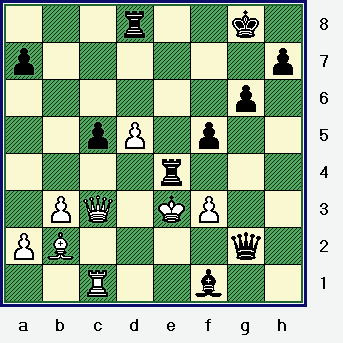
'!' - Fred Reinfeld.
GM John Nunn notes that Tarrasch
could have mated a little more
quickly here.
{See the line given
just below here.}
"Perhaps Tarrasch overlooked it -
but in view of the {tremendous} personal animosity between
the two
players, it is also possible that he
preferred the humiliating game
continuation ...
out of sadism." - GM John Nunn, in
the [Mammoth Book] of Great Chess Games.
>/= 28...Qg3+!;
29.Kd2 Qf2+; 30.Kd1 Qe2#.
as
in the game by playing:
"=" 28...Qxe4+!?;
29.Kf2 Qg2+;
30.Ke3 Qg3+; 31.Kd2 Qf2+;
32.Kd1 Qe2#. ]
The move of ...Qh2+; here also
{eventually} would win for Black,
but this is the most precise
way
to proceed in the current situation.
Ugly ... but completely forced.
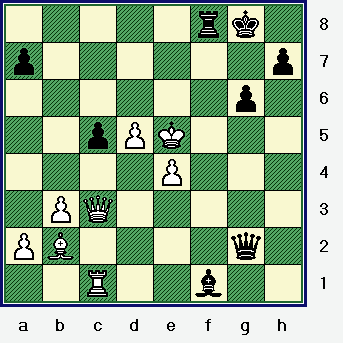
makes a strange
sight here.
one move longer
by giving away the Queen on
move 31). I should also point
out that
I have taught this game
a number of times - the average
student does not usually find
the
correct way to mate from here.
It does not matter ... nothing
will change the end result now.
- Fred
Reinfeld. ]
A wonderful and artistic finish ... (a pure mate)
to a very lovely combination by
one the greatest chess teachers
of all time. (This game received
the second overall
BRILLIANCY
PRIZE at this tournament. The
editor of the book commented
that had it not been for Lasker's
previous use of this idea 25
years before, he felt
quite sure
that it would have received
clear First Prize!!)
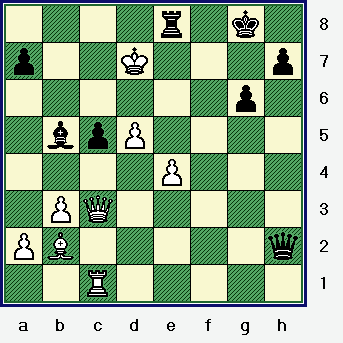
is not perfect ...
it is still very enjoyable and VERY
entertaining! Further - having now
annotated this contest for the "Nth"
time, I must rate this as being among
Tarrasch's ...
"TEN BEST GAMES!!!" {Any disagreement out there?}
on the King-side, which comprises the extremely
brilliant sacrifice of the Two Bishops.
The fact that it is Black who is responsible for this deed of valour
enhances the merit of the
performance. >>
GM Savielly
Tartakower &
James Du Mont
**************************************************************************
BIBLIOGRAPHY:
by GM John
Nunn, GM John Emms and FM Graham
Burgess.
Copyright (c) by the authors, 1998.
Published by Carroll & Graf, of NY. Printed by Robinson
Publishing of the United Kingdom. ISBN: # 0-7867-0587-6 (paper)
FIVE STARS
Copyright (c) by the author, 1947.
Reprinted in 1960 by Dover, New York, NY. (USA)
Published and printed in Canada
by General Publishing Comp, Ltd. (Lesmill Road, Toronto; Ontario.) ISBN: # 0-486-20644-0 (flex)
Annotations by many. Edited by S. Tarrasch and G. Marco.
English translation by R. Maxham.
Copyright (c) by Dale A. Brandeth.
Published (1993) by Caissa Editions,
Post Office Box # 151;
Yorklyn, DE / USA; 19736. ISBN: # 0-939433-17-6 (hard-back)
(The Best Chess
1900 - 1999 In Historical Context); by FM Graham Burgess.
Copyright (c) by the author, 1999.
Published/printed by Gambit Books. (Gambit Pub Ltd; London, ENG.) ISBN: # 1-901983-21-8 (HB)
Copyright (c) 1974. (HB) Printed by "Bell & Sons, Ltd." in
Great Britain for David McKay. ISBN: # 0-679-13040-3
Illustrative Game No. # 41. [Translated by J. du Mont.] Copyright (c) by the author. Reprinted in 1959 by Dover.
(Dover Publications, Inc.
180 Varick Street /
New York, NY; 10014 / USA) Printed in Canada by GPC, Ltd. ISBN: # 486-20528-02 (flex)
Copyright (c) by the author, 1951. Reprinted by Dover in 1976 -
a revised and expanded edition. ISBN: # 0-486-24512-8 (paper)
Originally published by "G. Bell & Sons, Ltd." (London and
New York.)
Later reprinted in 1975 by Dover Publications of New York City, NY.
(USA) ISBN: # 0-486-23208-5 (Game #
395, page # 505.)
*******************************************
0 - 1
All games ... the HTML code (was initially) generated with the program, ChessBase 8.0.
Most of the diagrams on this page were generated with the useful little program, Chess Captor 2.25.
This is a game that I have worked on many times. I don't mean to be a cry-baby, but the simple truth is I have annotated this game more than once ... a lot more than 3-4 times. (Maybe around twenty?) I never finished the long version ... I thought I had saved one version - a fairly lengthy one - on a floppy disk, but when I loaded into the computer a few weeks ago- around July - it was corrupted and completely unreadable. (NUTS!!) Needless to say ... this did not make me a happy camper!!
*******
Originally I was going to do a really quick analysis. But most of the pundits did SUCH a poor job of annotation ... I thought that it might be time someone at least tried to do a decent and objective job of analyzing this game.
I spent about 4-6 weeks on the analysis phase for this game ... but I did not do it all at once. It was done in bits and pieces - spread out over a period of many weeks. I also re-discovered what I already knew ... that electronic databases often have the completely incorrect score for many of these classic games.
When
this game is finished, it will represent the definitive job of analysis. {At
least on the Internet.}
(The serious student should also consult a few of the
books given in the Bibliography for this game.)
*******
I should also point out that I do not quibble with those people that say that the opening was not played very well. I should also remind you that this game was played in 1914. NO databases, NO computers, NO chess programs to analyze the game in, etc. This is also one of the prettiest combinations that Tarrasch ever played!
|
Click HERE to go (or return) to my HOME PAGE ... (for this site). Click HERE to go (or return) to my page on the "All-Time Best Games" of chess ever played. Click HERE to go (or return) to my most recent page for ANNOTATED CHESS GAMES. ******* Click HERE to check out my kicking domain! Click HERE to check out my second domain! |
This
HTML page was originally {first} created in August 2004. It was first posted on this web
site, Monday; September 13th, 2004.
The final format was completed on
Sunday, September 19th, 2004.
(Note: beginning in late 2006, I began a major
overhaul of this webpage. I redid many of the variations, added commentary,
corrected punctuation, redid all of the diagrams, etc. In short, its a
complete rework.) This
page
was last updated on: Sunday, June 09, 2013 02:06 PM
.
*******
Copyright (c) LM A.J. Goldsby I
Copyright © A.J. Goldsby, 2013. All rights reserved.
(This game was previewed by 15-20 people.)
